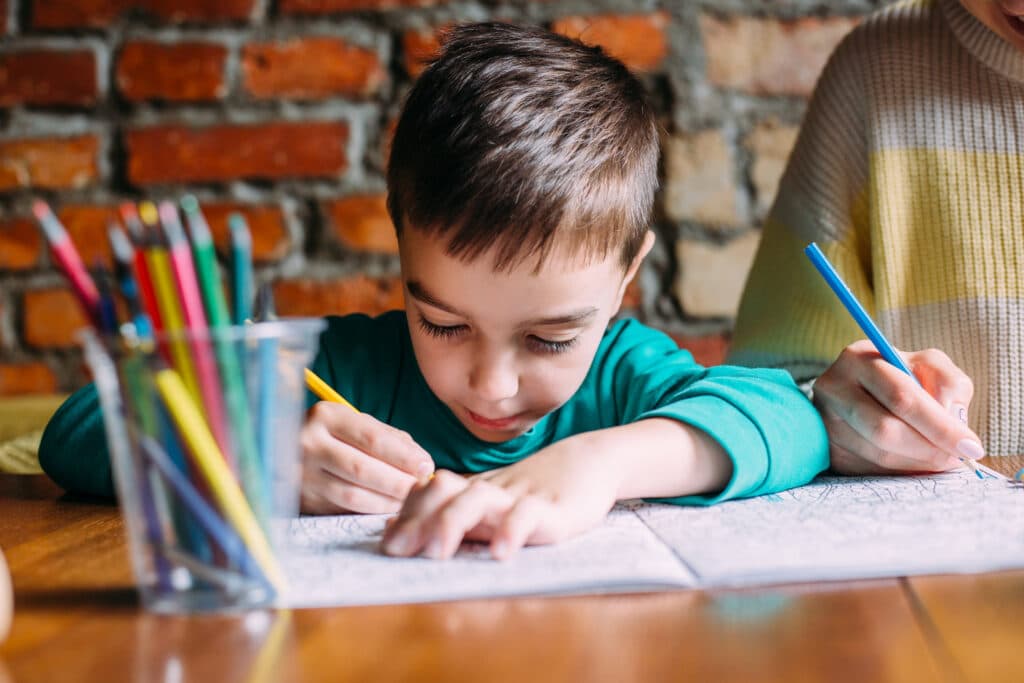Kindergarten Homeschool: How long should each day be?

It is not uncommon to homeschool one’s child, but it’s not overly popular either, depending on the nature of the child’s home and circumstances.
In kindergarten homeschool programs, most parents spend about two hours per day working on core academic concepts. This provides enough time for any formal learning that may happen in a regular classroom; however, it may be supplemented with activities such as music practice, sport practice, and time with friends.
Of course, homeschooling is more complicated than setting an allotted time every day of the week, it also includes flexibility with the kindergartener and how quick they are able to learn.
What Kindergarteners Should be Learning
Many know that kindergarteners learn a lot in their first year of school, yet it is still surprising just how much a kindergartener learns, whether in a classroom for a full day, half day, or learning at home. Children are eager learners, and their minds are ready and fully prepared to soak in all that they can.
Below is a list of many subjects a kindergartener learns: (Source)
- Alphabet
- Read
- Write
- Numbers
- Counting
- Shapes
- Plants
- Animals
- Five Senses
- Weather
- Time
- Seasons
- Geography

Knowing the alphabet is critical in any child’s learning. Many children go into kindergarten already knowing the alphabet, either because their parents had already taught them in their excitement, or because they have eager, older siblings who like to teach their younger siblings.
The alphabet is the key to the door of all knowledge. Following the alphabet, kindergarteners learn the sounds of those letters, and then put them together to say and read short words. The alphabet is also the key to the writing world, where children are taught how to write the letters and put them together to create short words that they can say, write, and read! And imagine their excitement when they are able to write their name for the first time!
Kindergarteners learn their numbers, as well as write them, and learn how to count, even up to simple addition and subtraction problems! They learn basic geometry, like circles, squares, and triangles, which they begin to see everywhere. They learn plants and animals, which they begin to see patterns of geometry in them, as well as notice their colors, and count how many leaves or petals or paws it has, write out what it’s called, as well as use their five senses!
Seriously, kindergarteners are amazing.
That’s not all. They already know their weathers and their seasons, but they learn more about them, why it’s called winter, or why it’s called spring, what a tornado is. They learn basic geography, of mountains, lakes… and they also learn about themselves in the process.
Teachers often put together activities that lead their students to learn more about themselves. Such as where they fall in their family, and what they like to do, and who they like to be with.
Kindergarten Homeschooling Schedule
Homeschooled kindergarteners do not need hours of school-time. They are young and don’t have a great attention span that older children possess. The thirty minutes to an hour and a half is the perfect amount of time for all types of learning. It may be longer or shorter on some days depending on their willingness to learn, and the breaks in between. (Source)
However, despite this short time, it doesn’t mean that having a schedule for the kindergartener should be dismissed. This author’s mother raised her child on a schedule, and found that the child did much better in schooling and in her personal interests when she was on a schedule. When she’s not, she becomes stressed, more disorganized, and feels hopeless.
Having a schedule or a routine will help the kindergartener learns the basics of living an adult life early, without even realizing it! Having a schedule will be engrained in their memory, and lead them to be more organized in their future, have a regular routine, as well as being more content with themselves. (Source)
The schedule does not have to be the same or exact every day. Variety and change is a good thing, and it prevents the days from becoming monotonous. The subjects that the child learns should not be long, their attention span is only about ten or fifteen minutes before they mentally wander off. Having a subject being taught for fifteen minutes is a good start, and can be adjusted according to the child’s needs.
An example of a simple week-long home-schooling schedule could be the following: (Source)
| Time | Monday | Tuesday | Wednesday | Thursday | Friday |
| 10:30 a.m. | Phonics | Phonics | Phonics | Phonics | Phonics |
| 10:45 a.m. | Reading | Reading | Reading | Reading | Reading |
| 11:00 a.m. | Writing | Writing | Writing | Writing | Writing |
| 11:15 a.m. | Math | Math | Math | Math | Math |
| 11:30 a.m. | Science | Art | Science | Field Trip Day | P.E. |
| 11:45 a.m. | Free-Reading | History | Free-Reading | History | Game time |
| 12:00 p.m. | Lunch/Outside Time | Lunch/Outside Time | Lunch/Outside Time | Lunch/Outside Time | Lunch/Outside Time |
Parents Teaching Homeschooled Kindergarteners

Homeschooling depends in every state. Make sure parents check their state laws when it comes to homeschooling, the process will be different for every one.
Some helpful tips and ideas when it comes to homeschooling a kindergartener: (Source 1, Source 2)
- Make sure there is time for play
- Be creative
- Read out loud
- Be flexible
Children can learn while they are able to play and explore. They see things while they play, and their curiosity often gets the best of them. So, they will have questions and come to their parents, who will be able to thoroughly answer their questions.
Please be creative while teaching kindergarteners, do not lecture them, children do not have a big attention span.
As a parent, read out loud, and encourage your kindergartener to read out loud as well. This will help instill the words in their mind and they will be able to recognize the words more quickly.
With flexibility, do not be afraid to take breaks. Kindergarten-aged kids have a lot of energy that must be used up, so don’t be afraid to finish a lesson and let them run outside for a minute.
Finally, don’t be afraid to try something new if a certain method doesn’t work. Know how your child learns best, and they will succeed splendidly.
